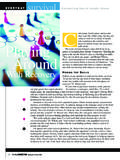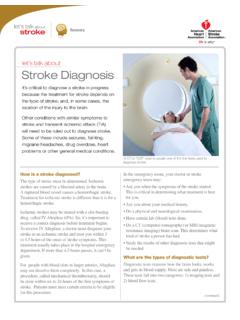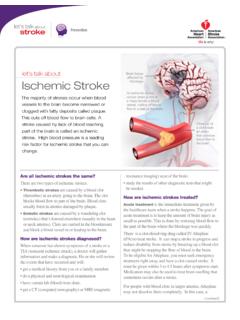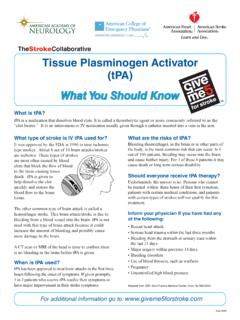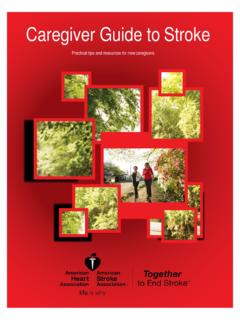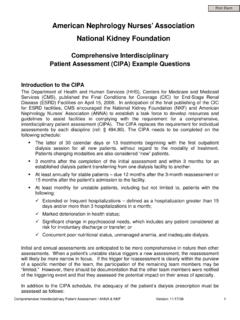Transcription of 2017 STROKE FACT SHEET - American Stroke …
1 STROKE occurs when blood flow to the brain is interrupted. Without oxygen-rich blood, brain cells die. 87% of strokes are classified as ischemic. An ischemic STROKE occurs when a clot or a mass blocks a blood vessel, cutting off blood flowto a part of the A hemorrhagic STROKE occurs when a weakened blood vessel, or cerebral aneurism, ruptures, spilling blood into the brain. Like ischemic STROKE ,a major cause of hemorrhagic STROKE is uncontrolled hypertension. A cryptogenic STROKE is a STROKE of unknown cause. About 1 in 3 ischemic strokes fall into this A TIA (transient ischemic attack) is often called a mini STROKE or warning STROKE . The difference between a TIA and a STROKE is that the blockage is transient, or temporary. Symptoms are exactly the same as STROKE , but usually last less than five minutes. Even if symptoms go away, emergency help should be called STROKE fact SHEETDEFINING STROKE About 795,000 people in the United States have a STROKE every year, with about three in four being first-time In the , about as many people have a STROKE each year (795,000) as a heart attack (790,000).
2 1 Someone in the United States has a STROKE every 40 seconds. Every four minutes, someone dies of STROKE is the No. 5 cause of death in the United States, killing more than 133,000 people a year (133,103) in 2014. That s 1 in every 20 In the between 2014 and 2015, STROKE mortality increased 3 percent after years of STROKE deaths are higher in the southeastern in an area known as the STROKE Belt : North Carolina, South Carolina, Georgia, Tennessee, Mississippi, Alabama, Louisiana, and Historically, the overall average STROKE mortality has been about 30 percent higher in the STROKE belt than in the rest of the STROKE is more disabling than it is fatal. An estimated million Americans 20 and older have had a Projections show that by 2030, an additional million adults 18 and older will have had a STROKE a increase from STROKE is a leading cause of long-term disability and the leading preventable cause of disability.
3 STROKE , or vascular dementia,is also a leading cause of memory STROKE INCIDENCE, MORTALITY and DISABILITY02 STROKE patients who receive tPA within 90 minutes of symptom onset are almost 3 x more likely to recover with little or no In 2015, AHA/ASA updated guidelines for acute ischemic STROKE to recommend the use of stent retrievers for eligible IV r-tPA (altaplase) is a drug to dissolve a clot, a stent retriever is a medical device used to pull it out. Guidelines recommendusing them together in eligible patients at capable facilities. In a recent study, the investigators found a 91% estimated probability of functional independence in eligible STROKE patients who received treatment with a stent retriever in Since 2013, overall awareness of the acronym for STROKE has steadily increased from 24% to 43%. This means 43% are atleast somewhat familiar with 6 For STROKE , someone other than the patient makes the decision to seek treatment in a majority of cases (66 percent of the time).
4 Telestroke allows neurologists to deliver remote treatment to STROKE patients through interactive videoconferencing. The appearance of nonmotor symptoms (such as speech difficulty) as the primary sympom and not using 911 are significant predictorsof treatment delay greater than two WARNING SIGNS and TREATMENT 80% of strokes can be What s good for your heart is good for your brain. The American Heart association recommends following Life s Simple 7 to achieve ideal health: don t smoke, be physically active, eat a healthy diet, maintain a healthy body weight, and control cholesterol, blood pressure and blood sugar. High blood pressure is a leading risk factor for Atrial fibrillation, which causes the heart to beat irregularly or rapidly, raises STROKE risk up to 5 times. It s often difficult to detect because it is sporadic and may not have STROKE risk is 2 to 4 times higher among smokers than nonsmokers or those who have quit for more than 10 years.
5 1 Exposure to secondhand smoke is a risk factor for STROKE . 1 Moderate to vigorous physical activity may reduce ischemic STROKE risk by 35%. 1 A history of STROKE in a first-degree relative increases the odds of STROKE by about 50%. 1 There is a positive association between higher estimated sodium intake and STROKE . 1 About 5 million Americans ( ) have had a self-reported physican-diagnosed TIA. The true prevalence is likely higher because many peoplewho experience symptoms consistant with a TIA fail to report About 15% of strokes are heralded by a transient ischemic attack (TIA), known as a warning STROKE or mini STROKE . People who have a TIAare more likely to have a STROKE within 90 PREVENTION and RISK FACTORS 03 About three in every four people (77%) who have a first STROKE have blood pressure higher than 140/90 mm One in three adults over the age of 20 ( million) has high blood Nearly 1 in 6 ( ) American adults with high blood pressure don t know they have Nearly half of people with high blood pressure ( ) do not have it under At age 50, total life expectancy is 5 years longer for someone without high blood pressure, compared to someone with A 10-mm Hg drop in systolic blood pressure (the top number in your reading), or a 5mmHg drop in diastolic pressure (bottom number)
6 Can cut your risk of STROKE death in Compared with whites, blacks develop high blood pressure earlier in life, and their average blood pressure is much BLOOD PRESSURE More women than men have strokes each year, in part because women live Each year in the , about about 55,000 more women than men have a After STROKE , women often have greater disability than More women die from STROKE (77,200) than from breast cancer (41,213) each year in the A woman s risk for STROKE is affected by hormonal status, pregnancy, childbirth and other gender specific risk Risk factors such as high blood pressure, migraine with aura, atrial fibrillation, diabetes, depression and emotional stress are strokerisk factors that tend to be stronger or more common in women than in STROKE during pregnancy affects 34 pregnant women out of 100,000, compared to 21 women out of 100,000 who are not in WOMEN 04 Non-Hispanic Blacks have nearly twice the risk for a first-ever STROKE as whites, and a much higher death rate from STROKE .
7 African-Americans are more likely to suffer a STROKE at a younger age. Among people ages 45 to 64, Non-Hispanic Blacks are two to threetimes more likely to have a STROKE compared to whites. African- American and Hispanic STROKE survivors are more likely to become disabled and have difficulty with activities of daily livingthan non-Hispanic whites. STROKE prevalence is projected to increase the most among Hispanic men between now and 2030. Lack of English proficiency is strongly associated with lack of STROKE knowledge among Hispanics. Diabetes increases STROKE risk at all ages. African-Americans, Hispanics/Latinos and other ethnic minorities bear a disproportionate burdenof diabetes in the STROKE in MULTICULTURALS Estimates of the overall annual incidence of STROKE in US children are per 100 000 children (0 to 15 years), with approximatelyhalf being hemmorahgic strokes. Compared with white children, black children in the have more than 2 times the risk of STROKE .
8 Maternal health and pregnancies are normal in most perinatal STROKE cases. Children with congenital heart disease have 19 times the risk of STROKE . Approximately 10% of all strokes occur in individuals 18 to 50 years of in CHILDREN and THE YOUNG05 The Furthering Access to STROKE Telemedicine (FAST) Act is a bill would require Medicare to pay for telestroke consultations regardlessof where the patient lives. President George H. W. Bush first declared May National STROKE Awareness Month, also known as American STROKE Month, in 1989. The AHA/ASA will continue to urge Congress to repeal Medicare s harmful caps on outpatient rehabilitative therapy for all Medicarebeneficiaries, including STROKE survivors. AHA/ASA is working to address inappropriate limits imposed on therapy services by private insurers, to support the Credit for Caring Actto provide a tax credit to family caregivers who are caring for STROKE survivors or others with disabilities, and for policies to prevent strokeand its risk factors.
9 Numerous state legislative and regulatory policy advancements have been achieved around the recognition by state health departmentsof all three tiers of STROKE facilities and require EMS authorities in the states to develop and implement transport protocol plans for acute STROKE patients. As of October 2016, 18 states and the District of Columbia have enacted these important policies. As of October 2016, 12 states and the District of Columbia have enacted policies across the country for the requirement of statewide STROKE registries that collect nationally approved consensus measures and POLICY WORK The American STROKE association is devoted to saving people from STROKE the No. 2 cause of death in the world and a leading cause ofserious disability. We team with millions of volunteers to fund innovative research, fight for stronger public health policies, and provide lifesaving tools and information to prevent and treat STROKE .
10 The Dallas-based association officially launched in 1998 as a division of the American Heart association . To learn more or to get involved, call 1-888-4 STROKE or visit Follow us on Facebook and the American STROKE ASSOCIATIONSOURCES: 1. Mozzafarian D et al. Circulation. 2017;135:e119-361 // 2. Sacco RL et al. Ann Neurol. 1989; 25(4):382-90; Desai AJ et al. Nat Clin Pract Cardiolvas Med. 2006;3(8):446-55 // 3. Xu JQ et al. 2016. National Center for Health Statistics NCHS data brief, no 267 // 4. Marler JR et al. Neurology. 2000;55(11)1649-55 // 5. Goyal M et al. Radiology. 2016;270(3):888-97 // 6. Ad Council STROKE Continuous Tracking Results November 2016 // 7. D Agostino, et al. STROKE . 1994;25:40-43 // 8. Neal B et al. Lancet. 2000;356;1955-64 // 9. Lewington S et al. Lancel. 2002;360:1903-13 // 10. Bushnell C et al. STROKE . 2014;45:8 // 11. NIH Budget and Appropriations The American Heart association / American STROKE association funds more research into cardiovascular diseases and STROKE than any organization except for the federal government.


